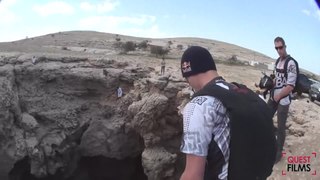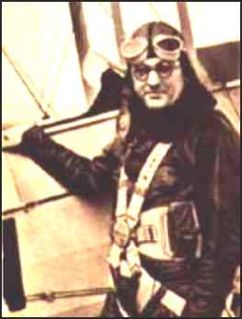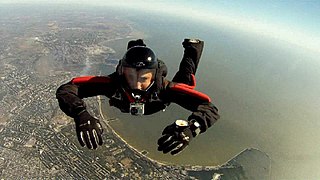Related Research Articles

BASE jumping is the recreational sport of jumping from fixed objects, using a parachute to descend safely to the ground. "BASE" is an acronym that stands for four categories of fixed objects from which one can jump: buildings, antenna, spans (bridges), and earth (cliffs). Participants exit from a fixed object such as a cliff, and after an optional freefall delay, deploy a parachute to slow their descent and land. A popular form of BASE jumping is wingsuit BASE jumping.

A parachute is a device used to slow the motion of an object through an atmosphere by creating drag or, in a ram-air parachute, aerodynamic lift. A major application is to support people, for recreation or as a safety device for aviators, who can exit from an aircraft at height and descend safely to earth.

A drogue parachute is a parachute designed for deployment from a rapidly-moving object. It can be used for various purposes, such as to decrease speed, to provide control and stability, or as a pilot parachute to deploy a larger parachute. Vehicles that have used drogue parachutes include multi-stage parachutes, aircraft, and spacecraft recovery systems.

CYPRES is an acronym for Cybernetic Parachute Release System. It refers to a specific make and model of an automatic activation device (AAD), a device that automatically activates a parachute under certain circumstances. A CYPRES is designed to activate the reserve parachute at a preset altitude if the rate of descent is over a certain threshold. The manufacturer of the CYPRES is Airtec.

Bill Booth is an American engineer, inventor, and entrepreneur in the skydiving equipment manufacturing industry. His invention of the 3-ring release safety device has enhanced skydiving safety. He founded the companies United Parachute Technologies and Complete Parachute Solutions, which had 150 employees as of 2015.

A malfunction is a partial or total failure of a parachuting device to operate as intended. Malfunctions may require a skydiver to cut away their main parachute and deploy the reserve parachute.

A pilot chute is a small auxiliary parachute used to deploy the main or reserve parachute. The pilot chute is connected by a bridle to the deployment bag containing the parachute. Pilot chutes are a critical component of all modern skydiving and BASE jumping gear. Pilot chutes are also used as a component of spacecraft such as NASA's Orion.
The Skyhook is United Parachute Technologies version of a Main-Assisted Reserve Deployment system (MARD), a safety feature on skydiving parachute systems. It builds on the concept underlying an ordinary reserve static line (RSL), which uses the force of the departing main parachute to open the reserve parachute compartment after the malfunctioning main parachute is cut-away, by further using the force of the departing main parachute to extract the reserve parachute out of the reserve compartment. This greatly decreases the time, and hence loss of altitude, required to fully open the reserve parachute.

Leslie Leroy Irvin was a stunt-man for the fledgling Californian film industry. Flying in balloons, he performed using trapeze acrobatics and parachute descents. For the 1914 film Sky High, Irvin made his first jump out of an airplane while flying at 1,000 feet above the ground. In 1918, he developed his own life-saving static line parachute, jumping with it several times and promoting it to the US Army. Irvin joined the Army Air Service's parachute research team at McCook Field near Dayton, Ohio where he made the first premeditated free-fall jump with the modern parachute on April 28, 1919.

Georgia Ann "Tiny" Thompson Broadwick, or Georgia Broadwick, previously known as Georgia Jacobs, and later known as Georgia Brown, was an American pioneering parachutist and the inventor of the ripcord. She was the first woman to jump from an airplane, and the first person to jump from a seaplane.
Georgia Brown may refer to:

Hilder Florentina Youngberg Smith was an aerial acrobat, parachutist, and pioneer aviator. She was one of California's first female pilots and the first woman to fly an airplane from LAX. Hilder was a member of a flying aerial team called The Flying Sylvesters.

James Floyd Smith was an inventor, aviation pioneer, and parachute manufacturer. With borrowed money, he built, then taught himself to fly his own airplane.

Ripcord was an American syndicated television series that ran for a total of 76 episodes from 1961 to 1963 about the exploits of a skydiving operation of its namesake.

Zdzisław Krasnodębski, alias Król was a Polish pilot, founder and commander of No. 303 Polish Fighter Squadron.

Parachuting, including also skydiving, is a method of transiting from a high point in the atmosphere to the surface of Earth with the aid of gravity, involving the control of speed during the descent using a parachute or parachutes.
CharlesBroadwick was an American pioneering parachutist and inventor. Speaking about Broadwick, an executive director of the U.S. Parachute Association, Ed Scott, said "just about all modern parachute systems" use ideas Broadwick developed: "an integrated, form-fitting harness and container system nestled on the back." Broadwick also developed the static line, a line from a parachute to an aircraft that pulls the parachute from its pouch. Static lines are still used today, for instance by paratroopers and novice skydivers. U.S. Army Warrant Officer Jeremiah Jones commented, "[Broadwick] is like the grandfather of paratroopers." In addition, Broadwick demonstrated parachute jumps at fairs and taught and equipped famous female parachutist Tiny Broadwick.
A closing pin is a curved piece of stainless steel metal used in the sport of skydiving. The pin is sewn onto the bridle, which is a 7- to 10-foot-long piece of nylon webbing connected to the pilot chute. The closing pin passes through the closing loop and in doing so, secures the main container of a skydiving rig, keeping the parachute from deploying prematurely. When the pilot chute is thrown out by the skydiver and catches air, it pulls the closing pin from the closing loop and allows the main parachute to be released from the container and inflate.

Edward Lincoln Hoffman (1884–1970) was a United States Army Air Service (USAAS) pilot, officer and Engineering Division Chief at McCook Field. With no parachute experience, he formed a team that included aviation pioneers Leslie Irvin and James Floyd Smith which developed the first modern parachute. The 1926 Collier Trophy was awarded to Major E. L. Hoffman, Air Corps for "development of a practical parachute;" the year's greatest achievement in American aviation.
A Main-Assisted Reserve Deployment (MARD) system is a skydiving safety device for parachute systems. While there are many variations, the operation and intended outcome for each is the same: open the reserve parachute container and extract the reserve parachute's deployment bag using the jettisoned main canopy. A MARD builds upon how a reserve static line (RSL) safety device works and in most circumstances, MARDs incorporate an RSL.
References
- ↑ "Georgia "Tiny" Broadwick's Parachute". National Air and Space Museum. 2015-03-12. Retrieved 2017-06-21.